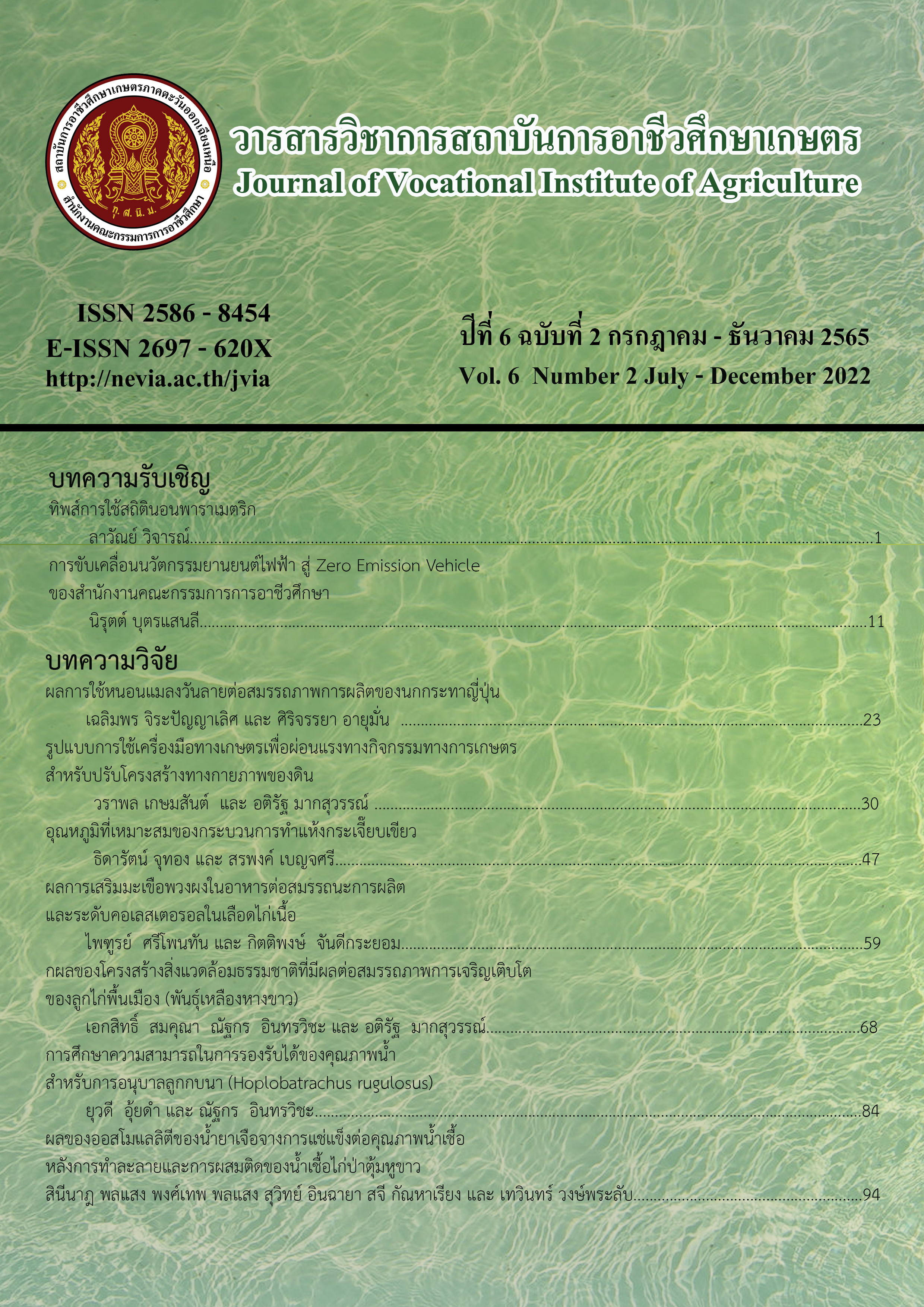Optimum Temperature for Drying Process of Okra Fruit
Main Article Content
Abstract
The okra (KN-OYV-02) were planted at the Faculty of Technology and Community Development, Phatthalung campus, Thaksin University for studying the appropriate conditions for okra blanching and drying process. Okra blanching methods, immersion in water and in boiling water with ascorbic acid (0, 1 and 2%) for 0, 2, 4 and 6 minutes, were compared. Blanching in boiling water for 4 mins without ascorbic acid preserved green color of okra. The okra showed yellow-brown color when blanching in boiling water with ascorbic acid. Subsequently, drying temperatures of hot-air dryer were observed at 60, 65 and 70 °C. Drying time was determined when water activity of okra was less than 0.6. Drying time decreased with an increase in drying temperature. Drying temperature at 60-65 °C and at 70 °C took 16 hrs and 12 hrs, respectively. Therefore, drying temperature at 70 °C was appropriated for okra drying process due to the short duration and maximum drying rate. In addition, L* and b* values of dried okra were decreased due to blanching and drying process but a* value of dried okra was increased when compared with fresh okra.
Article Details

This work is licensed under a Creative Commons Attribution-NonCommercial-NoDerivatives 4.0 International License.
The content and information in articles published in the Journal of Vocational Education in Agriculture are the opinions and responsibility of the article's author. The journal editors do not need to agree or share any responsibility.
Articles, information, content, etc. that are published in the Journal of Vocational Education in Agriculture are copyrighted by the Journal of Vocational Education in Agriculture. If any person or organization wishes to publish all or any part of it or to do anything. Only prior written permission from the Journal of Vocational Education in Agriculture is required.
References
สรพงค์ เบญจศรี และคณะ (2564). อิทธิพลของชนิดปุยต่อการเจริญเติบโตและผลผลิตของกระเจี๊ยบเขียวในภาคใตของประเทศไทย. วารสารวิชาการสถาบันการอาชีวศึกษาเกษตร, 5(2), 59-69.
กรมเศรษฐกิจระหว่างประเทศ กระทรวงต่างประเทศ. (2563). ผักและผลไม้. เข้าถึงได้จาก http://www.thaibiz.net/th/business/314.
Benchasri, S. (2012) Okra (Abelmoschus esculentus (L.) Moench) as a valuable vegetable of the world. Ratarstvo i povrtarstvo, 49(1), 105-112.
สกุลกานต์ สิมลา และ สรพงค์ เบญจศรี. (2558). การประเมินลักษณะทางการเกษตรและผลผลิตของกระเจี๊ยบเขียวในจังหวัดมหาสารคาม. แก่นเกษตร, 43(1), 894-899.
อัญจนา จันทร์ปะทิว และ วรรณพร สิทธิกานต์. (2562). อิทธิพลของระยะปลูกและอัตราการใช้ปุ๋ยเคมีที่มีผลต่อการเจริญเติบโตและองค์ประกอบของผลผลิตกระเจี๊ยบเขียว. แก่นเกษตร, 47(1), 1557-1562.
Lu, Y., et al. (2016). Oligomeric proanthocyanidins are the active compounds in Abelmoschus esculentus Moench for its α-amylase and α-glucosidase inhibition activity. Journal of Functional Foods, 20, 463–471.
Graham, J. O., et al. (2017). Total phenol content and antioxidant activity of okra seeds from different genotypes. American Journal of Food and Nutrition, 5(3), 90-94.
Zhang T., et al. (2018). Preliminary characterization and anti-hyperglycemic activity of a pectic polysaccharide from okra (Abelmoschus esculentus (L.) Moench). Journal of Functional Foods, 41, 19–24.
Benchasri, S., et al. (2020). The effect of genotypic variability on the yield and yield components of okra (Abelmoschus esculentus L. Moench) in Thailand. Asian Journal of Agriculture and Biology, 8(4), 480-490.
สรพงค์ เบญจศรี และชฎารัตน์ บุญจันทร์. (2554). ศึกษาความเป็นไปได้ในการตัดสินใจปลูกกระเจี๊ยบเขียวภายใต้ระบบเกษตรอินทรีย์เพื่อเป็นอาชีพเสริมของเกษตรกร ตำบลบ้านเภอป่าพะยอม จังหวัดพัทลุง. วารสารมหาวิทยาลัยนเรศวร, 19(1), 24–32.
Phornvillay, S., et al. (2020). Physio-biochemical responses of okra (Abelmoschus esculentus) to oxidative stress under low temperature storage. Horticulture Journal, 89(1), 69-77.
A.O.A.C. (1990). Official Methods of Analysis of Association of Official Analytical Chemistry. 15th ed. Wachington DC: A.O.A.C.
วิธู ชูศรี และคณะ. (2563). ผลของกระบวนการทำแห้งด้วยลมร้อนต่อสมบัติของกล้วยหอมสุกและฟักทองอบแห้ง. วารสารเทคโนโลยีการอาหาร มหาวิทยาลัยสยาม, 15(1), 37-52.
Erge ta la., (2008). Effect of heat treatment on chlorophyll degradation and color loss in green peas. GIDA, 33(5), 225-233.
Schmalko, M. E., et al. (2005). Effect of water activity and temperature in color and chlorophylls changes in Yerba Mate leaves. International Journal of Food Properties, 8(2), 313-322.
Ndukwu, M.C.(2009). Effect of drying temperature and drying air velocity on the drying rate and drying constant of cocoa bean. Agricultural Engineering International : The CIGR e-journal, XI, 1091(1-7).
Putra, R. N. & Ajiwiguna, T. A. (2017). Influence of Air Temperature and Velocity for Drying Process. Procedia Engineering, 170, 516–519.
เรวัฒ คำวัน และคณะ. (2561). การหาอัตราการแห้งตัวของขนุนโดยเครื่องอบแห้งอินฟราเรดระบบสุญญากาศ. วารสารวิชาการคณะเทคโนโลยีอุตสาหกรรม มหาวิทยาลัยราชภัฏลำปาง, 11(2), 67-77.

